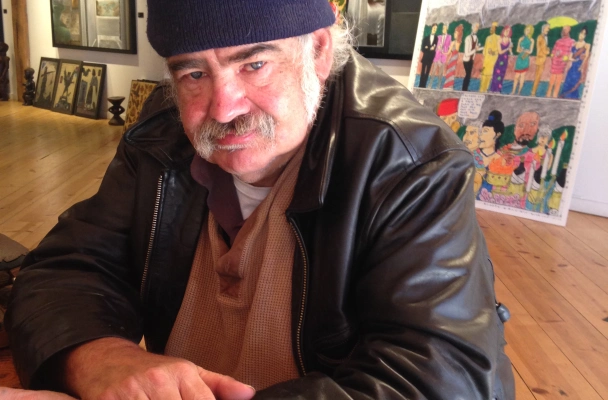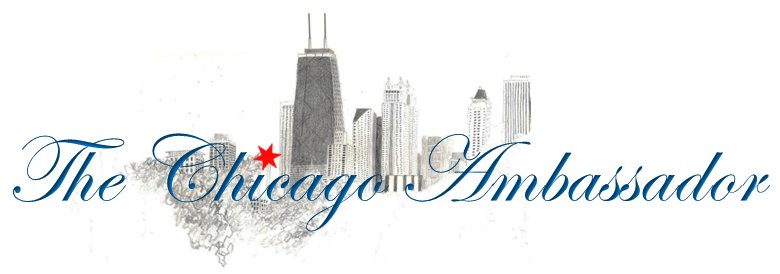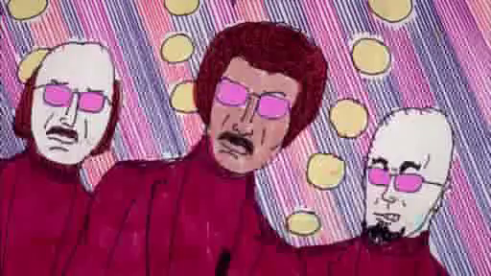Stephen Martin, the artist who chose to become homeless and used it as a muse

To describe an artist’s story as eccentric is sort of like naming the smartest member of MENSA, but Stephen Martin’s story does stand out in a scene full of unique characters. A self-taught artist, it wasn’t until he faced homelessness that he started what would become his life’s work. And while homeless, he ultimately approached an art gallery to have his work looked at. After being declined by the first gallery he approached, he found Ann Nathan, owner of The Ann Nathan Gallery, one of the most respected art houses in the city. There, Nathan said she saw something unique about his work and agreed to introduce Martin and his work to the art world.
What could be described as graphic novels, or long form comics, 59-year-old Martin has created 22 books at approximately 1,200 pages each. He uses both sides of the pages in his books, and must be careful that the ink he uses does not bleed through the pages. (Japanese gel pens and sequoia pens, some of which contain a sparkly, glitter-like material, are his preferred tools). Just as important, there is little if any room for error – his books are all original, one of a kind editions and a mistake would ruin at least two pages of work. Most of his books contain five or six stories each, and all are a continuing story about his character “Secret Agent Triple Nick Seven,” a James Bond type character that travels the world. Talking to Martin, he refers to Nick Seven as if he’s a real person, and considering that he says creating his stories helped keep him sane, perhaps he is in a way.
While Martin’s Nick Seven character is sophisticated and polished, Martin is not chic, trendy or “in the know”. Victor Armendariz of the Ann Nathan gallery summed Martin up by saying, “He’s not concerned with the fanciness of the art world. He was 90 minutes late for his show because he had fallen asleep.”
The Chicago Ambassador met with Martin recently at The Ann Nathan Gallery where he talked about his decision to leave his last job and thus wind up homeless, his health, and his work.

Stephen Martin. (Behind him are two blown up pages of one of his books. On the table is one of his books).
Interviewed by Bob Chiarito for The Chicago Ambassador.
CA) You overslept the day of your show in March?
MARTIN) I was two hours late. I had a rough day and forgot all about it. I suppose I was nervous about it. If they didn’t call, I probably would have missed it. Then my CTA card didn’t work, but the lady let me on.
CA) How long were you homeless?
MARTIN) I’ve been homeless for close to ten years.
CA) But now you have a place to stay?
MARTIN) Sort of. Since I’m trying to collect disability for the different conditions I have, I’ve been living at the Y. Once I get accepted for the disability, I’ll get a subsidy and then be able to decide where I want to go.
CA) When you first became homeless you started doing the books. Why was that?
MARTIN) More or less to keep my sanity. When you’re homeless, you have all these free hours. The only important thing is eating and sleeping. You have to do something with the rest of the day. A friend of mine came up to me and said ‘You should do this and I’ll get you buyers.’ People (he tried to sell to) would say ‘It’s too expensive’ and I’d tell them that they didn’t understand how much time is involved. That’s when I decided to go to check a few galleries. Ann [Nathan] was really my second choice. My friend told me to try someone else but they said no. I told Ann, you’re the only one around here who will be doing this. If this catches on, you’ll have something on your hands. So many of these paintings [motioning to the paintings in the gallery] are gorgeous, but once you look at it, it’s like a photograph, it’s over with. At least this stuff, it’s like watching a movie.
CA) That’s one thing that I noticed about your books. There are sections where it’s narrative without the pictures.
MARTIN) A lot of people don’t seem to understand the way comic books are made professionally. They get blown up and they shrink it down to size. You can’t please everybody, some people want it bigger, some want it smaller, some want the squares this way. So I said I’m going to do something that makes it easier for people, so I put the plot of the story in the beginning. It’s for all ages too. There’s a hint of sex, but there’s not any intercourse or anything like that. The language is borderline, violence is down to almost nothing.
CA) So the story is equally as important as the drawings?
MARTIN) Yeah. I wish I had the very first book. (It sold).
CA) Why is that?
MARTIN) Because his father starts out and then the son takes over. His father was a OS Agent in World War II, fighting Hitler.
CA) You’re talking about Nick Seven’s father? (His main character)
MARTIN) Yeah, Agent Seven. When he got killed by the Nazis, he (Nick) grew up and became a huge smuggler in the circus. Anyway, his father’s boss approached him and told him that he’d have complete amnesty if he joined the CIA. He thinks about it and then is told that it would give him the chance to catch his father’s killer. That’s when he decides to join. It’s one mission after another, he finally catches up with the guy and finds a bigger, more powerful organization than the Mafia. I throw a little bit of fantasy into it but try to keep it down because a lot of professional comic people think there’s too much of that. I try to make it almost like a James Bond movie.
CA) I did hear that you are a big Sean Connery fan. Did his Bond character inspire your stories?
MARTIN) I like his personality. He just left you at the end of the movie feeling like ‘I can’t wait until the next one.’ I was sorry to see him go.
CA) Before the Nick Seven books, did you ever write any stories?
MARTIN) I tried writing briefly, it’s very hard to do. Like a lot of writers, they type a paragraph and then they throw it away. This is easier for me.
CA) What about drawings, did you always draw?
MARTIN) I mainly doodled. I did do a few wall pictures. Those are hard to sell too. She’s (Ann) is trying sell one now. I sold a few on my own. The problem is, people are basically cheap in Chicago. You spend all that time, all that money and the sacrifice. I sold a picture to a church of what I thought Chicago looks like, my version. Sure enough, they had to get it cheap, and I said, “oh, okay.” Then they threw me a little bit of work here and there.
CA) Did you ever consider or think about having a book publisher publish these books?
MARTIN) That would depend on Ann.
One thing I learned, I read an article about James Bond and learned that Ian Fleming was ready to give up the series, he was going to have James Bond killed. Raymond Chandler told him, “No, hang in there.” President Kennedy read one of the books and enjoyed it and somehow it got into an article and it attracted the attention of movie producers. They came to Fleming and said ‘it’s too complex, we could fix it where the story moves.’ Next thing you know, they had a deal. I think there was only one book that they couldn’t sell. It takes exposure like that to get something off the ground.
CA) You had a job and quit knowing you’d end up homeless, is that correct?
MARTIN) I was never satisfied with my jobs. My last boss had Tourette’s syndrome. He would drive me up a wall. He’d come in whenever he wanted to, he’d call me up –
CA) What were you doing at the time?
MARTIN) I was working at an adult book store. He’d want me to do inventory his way. I said, ‘With all due respect, we could do it your way or we could do it my way. My way, I’m fast, quick and accurate. Your way, it will take me a long, long time.’ I didn’t want to come out and say that, but he had a knack for showing up when I didn’t want to see him. Either I was hung over or sick, and he’d come in and I’d think, ‘Oh God, now I have to survive two or three hours of this guy.’ He’d ask me advice but didn’t take it. I felt like, ‘Why don’t you just stay home and have your wife come in and pick up the money.’ One day I decided not to show up again. I had my last paycheck.
CA) Where were you living at the time?
MARTIN) At the Cedar Hotel. It’s out of business now.
CA) Living on the street must have been tough. How was that?
MARTIN) You pick up things from old people and friends. Where to eat, where to get things done. It wasn’t until the last three or four years that I ran into a church that had a clinic and they said I needed a physical. They found out I have Hepatitis C, anxiety disorder, and a bunch of other stuff. Some stuff I can’t even pronounce. They told me that they could help me get a check.
CA) Was there an area you’d stay near when you were homeless?
MARTIN) I was by North Avenue, by the Moody Bible Institute. It was a lot safer. We had the respect of the cops and we’d look out for the church.
CA) Was it hard to keep the books in good shape when you were living on the street?
MARTIN) The beat up ones are from when I lived on the street. It was always hard. You worry about the elements, the rain, the snow. The more stuff you carry, you have to carry your blankets too. It wasn’t until I hooked up with the Lawson House (YMCA) that I started getting better copies.
CA) You stay there?
MARTIN) Yeah, I’ve been there for two years. That’s where they hold you until you get approved. It’s not my idea of a thrill but what are you going to do.
CA) One of the first things someone notices about your books is that you use both sides of the pages. Can you talk about that?
MARTIN) I have to be careful not to use any ink that leaks through.
CA) It’s kinda like walking a tightrope without a net. What happens if you make a mistake?
MARTIN) You have to be very careful.
CA) Do you work on it everyday?
MARTIN) Just about. I had to cut back a bit because of my doctor appointments. But I try to work on it early in the morning and then when I come back from the doctor.
CA) You must go through a lot of pens and ink.
MARTIN) Yeah, I try to make sure I don’t run out. The hardest thing to hold on to is sketch paints.
CA) Why is that, do they run out fast?
MARTIN) Sometimes they run out, or sometimes the art store doesn’t have a supply of them.
CA) When you first dealt with Ann, she was receptive?
MARTIN) She was a little hard to get along with at first. I could see why, she wanted to see what was in it for her. It took us a little while to get used to each other. Now we get along a lot better than we did in the beginning. It wasn’t that we hated each other or anything, we just had to understand each other as business people. She has her way, I have my way.
CA) Do you have any family?
MARTIN) I have one sister left. My mother and father are gone. I had a sister who committed suicide. That’s it. I haven’t seen my sister in years. As far as I know, she still lives in Tennessee. She draws too. My father was a draftsman and he was pretty good. I could have been a draftsman too but I was too busy working on Rush Street and nightclubs. That’s how I wound up with a shoddy career, but I enjoyed it because I was my own boss.
CA) How long does a book take you to complete?
MARTIN) When I was outdoors, it took close to 3 months. Now it varies. Sometimes I get it done quick, sometimes it takes longer, depending on my appointments and all that.
CA) Do you have the story in your head or write as you go?
MARTIN) I write it down [in a separate notebook]. Because sometimes I misspell, or sometimes a character doesn’t fit right. I don’t use many black people in the books because I can’t find the right color for their skin tone. Indians from India, I have to cut down too. At first I used flesh tone but I stopped that.
CA) Victor (from the Ann Nathan Gallery) was talking about how some of the settings in the books are in Monaco or in different countries. Have you ever travelled outside of Illinois?
MARTIN) No, I would get magazines and get ideas. Mostly, travel magazines. Then when I drew, I’d think, this looks like Morocco, or this looks like Mexico. Who’s going to know the difference? I mean, you can’t pass Tokyo for Mexico though. I learned a lot from TV shows too.
Have you ever seen that movie “Watchmen”? I haven’t but I heard it was 25 years in the making because it was so painstakingly done.
CA) No, I haven’t, but I know it was a graphic novel.
MARTIN) I have the DVD of “Sin City.” That was also a graphic novel.
CA) What if someone wanted to make a movie from your books?
MARTIN) Oh yeah. They wouldn’t be able to get the sparkle however.
I suggested to her (Ann) that I could do a ‘make your own projects’ kind of book, where you’d cut out the squares and things like that.
CA) Like a choose your own adventure book?
MARTIN) People could just use their own imagination. Almost what Hollywood does. Sometimes they re-release movies with scenes that they didn’t show the public. They did that with Spartacus, they added 10 minutes.
I enjoy working in the parks and at the (Lincoln Park) zoo. It makes me feel like a kid again when I draw in front of the kids. They come by and ask what I’m doing. I told my therapist and he said there’s nothing wrong with that as long as a parent is around. The next thing I know, I’m getting inspiration.
CA) From the kids?
MARTIN) Yeah.
CA) Are you still doing more books?
MARTIN) Oh yeah. I’m working on one now that’s more than halfway done.
Be sure to “Like” us on Facebook!






3 Responses to “Stephen Martin, the artist who chose to become homeless and used it as a muse”
I was the friend of Steven Martin that sent him to the Judith Saslow Gallery. I told Steven, “If Judith wont handle your stuff, she will send you to someone who will”
Later that day Steven walked over to me and handed me a couple twenty dollar bills!
I have a pencil drawing signed by Stephen D. Martin dated July 1st, 1980 on just regular drawing paper. I live near Knoxville, TN. Could this be the same Stephen Martin in this story?
No idea. I suppose it’s possible.